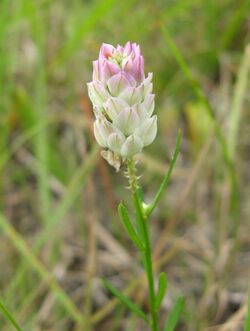Biology:Polygala sanguinea
| Polygala sanguinea | |
|---|---|

| |
| Scientific classification | |
| Kingdom: | Plantae |
| Clade: | Tracheophytes |
| Clade: | Angiosperms |
| Clade: | Eudicots |
| Clade: | Rosids |
| Order: | Fabales |
| Family: | Polygalaceae |
| Genus: | Polygala |
| Species: | P. sanguinea
|
| Binomial name | |
| Polygala sanguinea | |
Polygala sanguinea, known as purple milkwort,[1] field milkwort,[2] or blood milkwort[3] is an annual plant in the Polygalaceae (milkwort) family. It is native to central and eastern North America.
Description
P. sanguinea grows to a height of 10–30 centimetres (4–12 in). The plant has a single, generally unbranched, hairless stem that terminates in a spike-like dense raceme of flowers that is approximately 3 centimetres (1 in) long and 1.3 centimetres (.5 in) across. The flowers are pink, green, or occasionally white. After blooming, the flowers are replaced by 2 hairy seeds within a capsule.[4] The leaves are widely spaced along the stem, alternate, and linear or narrowly elliptical.[5] When crushed, the root of the plant smells of wintergreen.[6]
Distribution and habitat
The plant is native to widespread areas of eastern North America. It is native in the United States from New Mexico to the west, the Canadian border to the north, Texas to the south, and the coast to the east (except in Florida). In Canada, it is native in Ontario, Quebec, New Brunswick, Nova Scotia, and Prince Edward Island.[7]
P. sanguinea is it generally found in wet, acidic soils in open areas such as prairies and fields.[5]
Ecology
Flowers bloom from May to October.[5] Small to medium-sized bees and bee flies are attracted to the pollen and nectar.
References
- ↑ "Polygala sanguinea". Natural Resources Conservation Service PLANTS Database. USDA. https://plants.usda.gov/core/profile?symbol=POSA3. Retrieved 11 October 2015.
- ↑ "Field Milkwort (Polygala sanguinea)". https://www.illinoiswildflowers.info/prairie/plantx/field_milkwortx.htm.
- ↑ "Polygala sanguinea (blood milkwort, purple milkwort): Go Botany". https://gobotany.nativeplanttrust.org/species/polygala/sanguinea/.
- ↑ Polygala sanguinea at Illinois Wildflowers
- ↑ 5.0 5.1 5.2 Denison, Edgar (2017). Missouri Wildflowers. Conservation Commission of the State of Missouri. pp. 68. ISBN 978-1-887247-59-7.
- ↑ "Lady Bird Johnson Wildflower Center - The University of Texas at Austin". https://www.wildflower.org/plants/result.php?id_plant=POSA3.
- ↑ "Polygala sanguinea", County-level distribution map from the North American Plant Atlas (NAPA) (Biota of North America Program (BONAP)), 2014, http://bonap.net/MapGallery/County/Polygala%20sanguinea.png, retrieved 21 January 2017
Wikidata ☰ Q16757636 entry
 |


